Please Take Note: This is a review of the final game, but it might change slightly based on the success of the Kickstarter campaign. The game is being reviewed on the components and the rules provided with the understanding that “what you see is not what you might get” when the game is published. If you like what you read and want to learn more, we encourage you to visit the game’s webpage. Now that we have all that disclaimer junk out of the way, on with the review.

The Basics:
- For ages 10 and up
- For 2 to 4 players
- Approximately 60 minutes to complete
Geek Skills:
- Counting & Math
- Logical & Critical Decision Making
- Reading
- Pattern/Color Matching
- Strategy & Tactics
- Risk vs. Reward
- Visuospatial Skills
- Hand/Resource Management
Learning Curve:
- Child – Easy
- Adult – Easy
Theme & Narrative:
- Build a spectacular dungeon with all the trimmings
Endorsements:
- Gamer Geek approved!
- Parent Geek approved!
- Child Geek approved!
Overview
English interior designer and socialite, Nicky Haslam, said, “Interior decoration partly thrives on being social.” Which makes sense, but how would that work if you were tasked to design the “perfect dungeon” for a malevolent evil entity with a penchant for ruling the world with an iron fist? What kind of throw pillow fabric pattern goes well with hanging skeletons and flesh-eating monsters? Paisley? Maybe. In this game, you get to make all those choices. You’ve been hired to design the perfect dungeon, with twists, turns, and the proper accents to make the evil dwelling really “pop”!
Dungeon Decorators, designed by Jeff LaFlam and to be published by SlugFest Games, will reportedly be comprised of one Drafting board, 120 double-sided “Decoration” Dungeon tiles, ten double-sided “Generic” Dungeon tiles, one Arcane Architecture token, 10 Decorate Mimic token, three Clock tiles, four Starting tiles, 18 Boss Goal cards (comprised of two decks, yellow and blue cards), 36 Shape Goal cards, 36 Decoration Goal cards, four Player pawns, four Player boards, one Scoring track, four Score Tracking cubes, eight “50-point” chits, four rule reminder cards, one handsome blue “First Half” bag and one an eye-popping “Second Half” bag (that really ties the room together). As this is a review of a prepublished game, I cannot comment on the game component quality.
Preparing to Decorate
To set up the game, first have each player select a color of their choice and then take the matching colored Player pawn, Score cubes, Starting tile, and Player board. Any not used should be returned to the game box. Players should place their Starting tile in front of them at this time.
Second, place the Score track to one side of the game playing area and have each player place their Score cube on the “0” space.
Third, place the Drafting board to the center of the game playing area and randomly place the Player pawns into the circular spots found on the sides, starting with the spaced marked “1”. Proceed with each subsequent Player pawn placement with the next highest number. Use one side when placing the pawns.
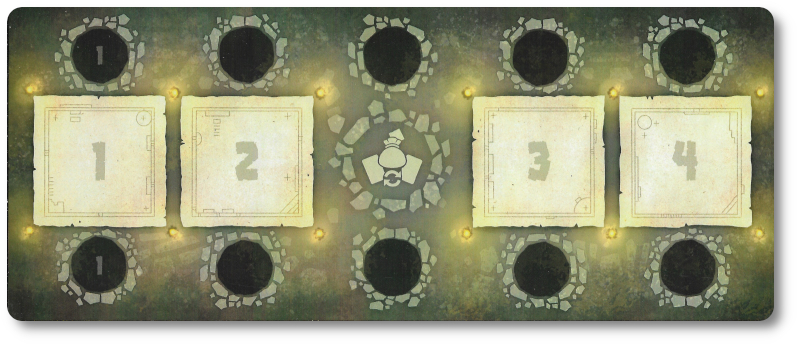
Fourth, shuffle the 120 “Generic” and “Decoractive” Dungeon tiles together. Randomly choose 20 and remove for the duration of the game. Then randomly choose 50 and place in the blue “First Half” bag. The remaining tiles go into the red “Second Half” bag, along with the three Clock tiles.
Fifth, shuffle the two Boss Goal decks, keeping the colors separate. Draw one card from each deck, revealing it and placing face-up for all players to see. These cards determine how players can score bonus points when the final scores are calculated. Return the decks to the game box for the duration of the game.
Sixth, shuffle the Shape Goal cards and Decoration Goal cards separately. Deal three cards from each deck to each player (three Shape Goal and three Decorative Goal cards per player). The player reviews the cards they were dealt and discards any two they like from a total of six cards in their hand. The discarded cards should remain face-down.
That’s it for the game set up. Time to make the dungeon fabulous! Turn order is determined by the Player pawn placement on the Drafting board.
Bedazzling the Dungeon!
Dungeon Decorators is played in turns and rounds with no set number of rounds per game. Before a round begins, it must be set by completing the following steps:
- Remove and discard any tiles still on the Drafting board from the previous round.
- Draw four new tiles from the current bag being used (first or second half), placing the tiles on the Drafting board in low to high numerical order with the decoration side face-up.
If during the round set up all the tiles from the blue “First Half” bag are used, continue to fill the Drafting board using the red “Second Half” bag.
After the round is set, the player takes their turn in the turn order noted on the Drafting board, starting with the player in the “1” position. A player’s turn is comprised of the following steps:
Step One: Draft a Tile
To draft a tile, the player takes their Player pawn on one side of the Drafting board and moves it to the other side on the space next to the tile they want to collect. The player then collects the tile and places it in front of them. It’s not placed in the dungeon during this step. Players should take note that where they place their Player pawn not only indicates what tile they will collect, but also determines the next round’s player turn order.
Players are given a good deal of information when reviewing the tiles that can be drafted. This is done through “room clues”. For example, the below tile shows what decorations are available if you glance at it quickly, but take a moment to give it a longer look. It also shows a star and has four decorations in total. This means that the room on the other side has a “Star” icon (which is used when scoring) and is a four-way hallway.
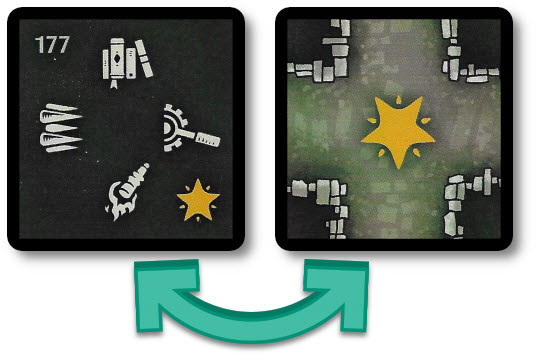
Optionally, players may place their Player pawn on a special spot found on the Drafting board referred to as the “Exchange”. This indicates that the player will not take a tile this round from the Drafting board. Instead, they randomly draw one tile from the current bag in use and place that tile in front of them. They then draw one card from either the Shape Goal or the Decorate Goal deck, discarding any one card from their hand.
The “Exchange” spot can only be occupied by one player per round.
If a player, at any time, draws a Clock tile, place it aside and draw again. If the third and final Clock tile is drawn, the endgame is triggered.
Step Two: Resolve Assistant Icon
Some tiles have an Assitant icon. These special helpers provide the player with a unique action on their turn. In summary:
- Goblin Sapper allows the player to take a “Generic” Dungeon tile. This tile must be placed in the player’s dungeon during the next step or placed in storage.
- Burrow Bro allows the player to draw two tiles from the current bag in use, choosing one to keep from the two drawn and the one selected during the draft. The kept tile remains in front of the player with the other two being discarded. If the selected tile has an Assistant icon other than another Burrow Bro, resolve it at this time, as well. Any drawn Clock tiles are set aside, and the player draws again.
- Arcane Architect allows the player to collect the Arcane Architect token, which can be used during the build step.
- Decorate Mimic allows the player to collect the Decorate Mimic token, which can be used during the scoring step.
Step Three: Build
Now the player gets to take their tile and add it to their dungeon! Placing a Dungeon tile has a few rules to keep in mind.
- Dungeon tiles can be rotated or flipped however the player likes before placing to their dungeon (tiles either show decorations or room/hallway).
- Once a tile is placed it cannot be moved (except when using the Arcane Architect that allows the player to move a tile previously placed).
- To place a Dungeon tile using its decorative side, it must be placed so it’s adjacent to at least one wall already found in the player’s dungeon. Placement of the decorations may not cause a passageway to come to an abrupt dead-end. The decoration icon that touches a wall indicates what decoration is located at that specific spot.
- To place a Dungeon tile using its room side, you cannot place it so it dead-ends into a decorative tile previously placed. In addition, the player must be able to “walk” to the newly placed tile from their Starting Dungeon tile. Finally, a player’s dungeon must always have at least one open passageway leading to an empty space that can be used for future building. That is to say, a player cannot close their dungeon.

Adding decorations, twisty hallways, and open rooms to the player’s dungeon is more than just randomly placing the tile to a location that works. During the game, players try to create specific shapes using their tiles and adoring their dungeons with specific decorations (as noted by their Shape Goal and Decoration Goal cards). In addition, the two Boss cards indicate how players can score additional points by fulfilling the listed requirements.
If the player finds that they cannot legally place their tile, they may place it in storage (one of two spots found on their Player board). If the player’s storage is full and they cannot place their tile, they must discard one of their tiles in storage or the tile they currently have to place, making room in their storage for the extra tile.
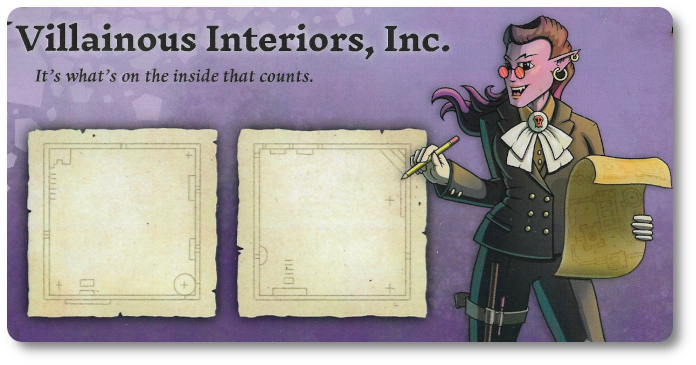
Step Four: Score
The player now reviews their dungeon and compares it to what is listed on their Shape Goal and Decoration Goal cards. For each condition met by the player’s dungeon that fulfills the Goal card, they play that card face-up at this time. Points are then scored per the card’s instruction using the Score cubes on the scoring track. The played Goal cards are discarded.
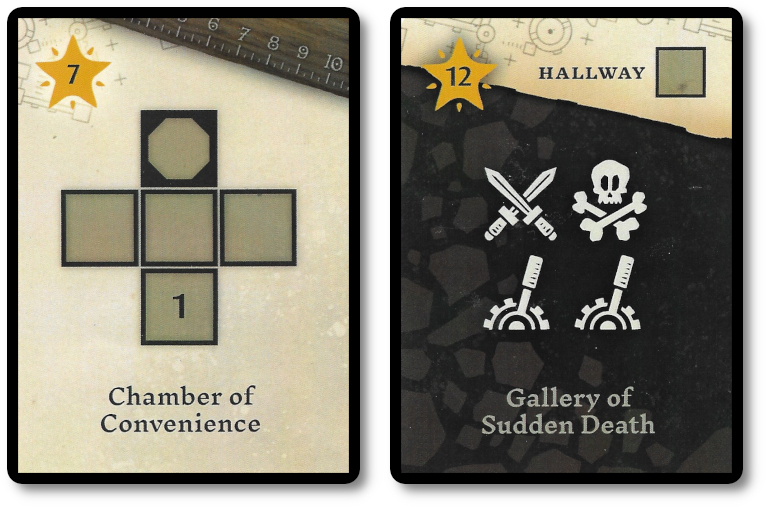
Shape Goal on the left, Decoration Goal on the right
The player can use the Decorative Mimic token if they currently have it in their possession. The Mimic allows the player to turn any “wild” decoration into any decoration type they want for scoring purposes, but only this one time during the player’s turn and for only one Goal card. The “wild” decoration returns to its natural state after being scored.
Step Five: Refill Hand
For their last action during their turn, the player may draw any number of Shape Goal or Decoration Goal cards into their hand for a maximum of four cards, but only if they end their turn during this step with fewer than four cards in their hand. For example, if the player has two Goal cards in their hand, they may draw two Shape Goal cards, two Decoration Goal cards, or one of each resulting in four total cards in the player’s hand.
Shuffle the discarded Goal cards if the decks run out of cards.
This completes the player’s turn. The next player in the turn order sequence, as indicated by the player’s pawns potion, now takes their turn.
Beauty and the Beholder
Once the third Clock tile is drawn, the end game is triggered. All players complete their final turn for the round, ensuring that all players have had the same number of turns during the game. The one exception to this rule is if the third Clock tile is drawn during the round set up. In which case, the round does not start, and players go immediately to scoring.
Scoring is completed by calculating the following:
- For each “star” in the player’s dungeon found on the room and passageway sides, they earn three points.
- Based on the number of different colors found in the player’s dungeon as displayed on the room and passageway side, they can score anywhere from zero to 14 points.
- Based on the total number of the most common color in their dungeon, they can score anywhere from zero to 24 points.
- Additional bonus points are then calculated if the player met the requirements listed on the Boss cards.
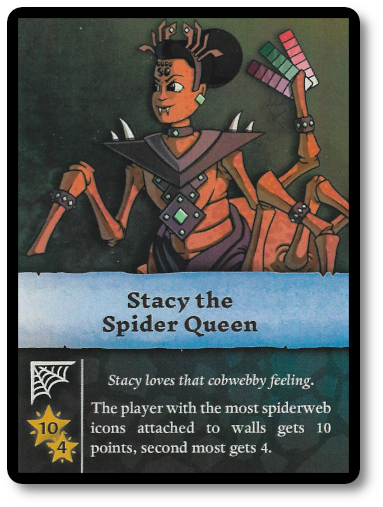
Once all the points are calculated, the player with the highest number of points wins the game.
To learn more about Dungeon Decorators, visit the game’s webpage.
Final Word
 The Child Geeks enjoyed the game, finding it to be a fun puzzle to use their selected tiles to not only build visually interesting dungeons but also meeting the requirements shown on their cards. They seldomly paid attention to the Boss cards, finding those points to be a true “bonus” that didn’t matter to them while playing. According to one Child Geek, “What I like best is the way you get to control everything about your dungeon. Your cards help you know how to build, but you get to do all the decision making.” Another Child Geek said, “You have to be really careful how you build so you don’t put yourself in a corner, but you can always get assistance to help you rearrange your dungeon. I never felt like I was stuck, but I do think you can get overwhelmed if you don’t just stick to your goal cards.” This Child Geek brings up a good point. Where to place your Dungeon tile can feel overwhelming as the dungeon begins to grow. This could make some players – especially inexperienced ones – feel a bit stressed. There is no time limit, however, for the player to think it through, and they can always ask other players for help. When the final picture was hung next to the skeleton, the Child Geeks took a step back and gave Dungeon Decorators their full approval.
The Child Geeks enjoyed the game, finding it to be a fun puzzle to use their selected tiles to not only build visually interesting dungeons but also meeting the requirements shown on their cards. They seldomly paid attention to the Boss cards, finding those points to be a true “bonus” that didn’t matter to them while playing. According to one Child Geek, “What I like best is the way you get to control everything about your dungeon. Your cards help you know how to build, but you get to do all the decision making.” Another Child Geek said, “You have to be really careful how you build so you don’t put yourself in a corner, but you can always get assistance to help you rearrange your dungeon. I never felt like I was stuck, but I do think you can get overwhelmed if you don’t just stick to your goal cards.” This Child Geek brings up a good point. Where to place your Dungeon tile can feel overwhelming as the dungeon begins to grow. This could make some players – especially inexperienced ones – feel a bit stressed. There is no time limit, however, for the player to think it through, and they can always ask other players for help. When the final picture was hung next to the skeleton, the Child Geeks took a step back and gave Dungeon Decorators their full approval.
 The Parent Geeks also found the game fun, believing it to be an excellent mental exercise in pattern matching, shape creation, and creative thinking. According to one Parent Geek, “Tile placement games like this are my favorite—endless ways to create and mesh together different ideas. I appreciate the fact that I have a hand full of cards that help me make choices, too. In this game, even if you are a novice interior decorator, you always have direction.” Another Parent Geek said, “A colorful and entertaining game. Each turn feels empowering and important, but never overwhelming. All my goals always felt attainable, too. I only wish I had more time! Those silly Clock tiles keep appearing at the wrong moment!” Since the second half of the game ends randomly, players must redouble their efforts to complete their dungeons. While the stress to do so does pick up, so does the excitement, as each tile drawn could bring the game to a close! After the blood-red paint dried on the dungeon walls, the Parent Geeks all agreed that Dungeon Decorators was worth their time at their family gaming table.
The Parent Geeks also found the game fun, believing it to be an excellent mental exercise in pattern matching, shape creation, and creative thinking. According to one Parent Geek, “Tile placement games like this are my favorite—endless ways to create and mesh together different ideas. I appreciate the fact that I have a hand full of cards that help me make choices, too. In this game, even if you are a novice interior decorator, you always have direction.” Another Parent Geek said, “A colorful and entertaining game. Each turn feels empowering and important, but never overwhelming. All my goals always felt attainable, too. I only wish I had more time! Those silly Clock tiles keep appearing at the wrong moment!” Since the second half of the game ends randomly, players must redouble their efforts to complete their dungeons. While the stress to do so does pick up, so does the excitement, as each tile drawn could bring the game to a close! After the blood-red paint dried on the dungeon walls, the Parent Geeks all agreed that Dungeon Decorators was worth their time at their family gaming table.
 The Gamer Geeks enjoyed the game, finding it casual in its approach, but involved in its execution. According to one Gamer Geek, “Reminds me a good deal of many, many other tile games I have played in the past. And on that note, I don’t think this game gets any points for being original. Still, the game is solid, and I was entertained. I wish more fantasy dungeon-like things were going on, but the game is solid. I’d play it again when a casual game was needed with my playing group.” Another Gamer Geek said, “A game I enjoyed. It was easy enough for my husband and kids to learn, but it still had more than enough depth, strategy, and tactics to keep me engaged, as well. I’d say this is a great game for the gaming family or for gamers who want a tile-placement game that can be played casually, but still requires a lot of attention to detail.” After the throw pillows were properly fluffed on the stone and bone thrown, the Gamer Geeks all agreed that Dungeon Decorators did a good enough job to earn their approval.
The Gamer Geeks enjoyed the game, finding it casual in its approach, but involved in its execution. According to one Gamer Geek, “Reminds me a good deal of many, many other tile games I have played in the past. And on that note, I don’t think this game gets any points for being original. Still, the game is solid, and I was entertained. I wish more fantasy dungeon-like things were going on, but the game is solid. I’d play it again when a casual game was needed with my playing group.” Another Gamer Geek said, “A game I enjoyed. It was easy enough for my husband and kids to learn, but it still had more than enough depth, strategy, and tactics to keep me engaged, as well. I’d say this is a great game for the gaming family or for gamers who want a tile-placement game that can be played casually, but still requires a lot of attention to detail.” After the throw pillows were properly fluffed on the stone and bone thrown, the Gamer Geeks all agreed that Dungeon Decorators did a good enough job to earn their approval.
 Dungeon Decorators was a lot of fun to play. As previously said by many of our players, the game is easy to approach, easy to learn, and that is where “easy” ends. Each tile, if properly placed, gets the player ever closer to scoring points. At the same time, each tile added to their dungeon becomes a semi-permanent addition that must then be worked around if mistakes are made. And boy, talk about painful mistakes. This is a game that teaches you to think ahead, but only in hindsight. You cannot build to future unknowns. The only points a player knows for sure are within their reach are those listed on the cards in their hand and bonus points indicated on the Boss cards.
Dungeon Decorators was a lot of fun to play. As previously said by many of our players, the game is easy to approach, easy to learn, and that is where “easy” ends. Each tile, if properly placed, gets the player ever closer to scoring points. At the same time, each tile added to their dungeon becomes a semi-permanent addition that must then be worked around if mistakes are made. And boy, talk about painful mistakes. This is a game that teaches you to think ahead, but only in hindsight. You cannot build to future unknowns. The only points a player knows for sure are within their reach are those listed on the cards in their hand and bonus points indicated on the Boss cards.
Is that enough? You bet. This information gives players all they need to be successful going forward. As they draw new cards, players will wince as they see they were just shy of making specific requirements. Of course, players can always go back and redecorate, but that takes time. Time, I might add, that players must manage. Each tile drawn during the second half of the game has an ever-increasing chance of bringing the game to a close.
Another aspect of the game I enjoyed is the known points you earn by simply building your dungeon intelligently. The Goal and Boss cards are great as they introduce random scoring options that are different each time you play the game. The big points, however, never change. Building the room with just the right amount of colors and stars will award the player with many points at the end of the game. The problem here is that these points are only realized at the end. As such, they are frequently forgotten until the second half, which is hilarious and not surprising. The Goal and Boss cards are HUGE carrots for the player to go chase. It feels great to play a card and score those points! But never forget that at the end of the game, dungeons are evaluated. To win this game, you must think in both the short and long term. Proper placement to obtain quick points could cost you a good deal more when the game ends if you are not careful.
I do recommend you play Dungeon Decorators when time allows. It’s similar to several other tile placement games available in the market today, but only in the sense that most tile placement games are pretty much identical when it comes to the gameplay. That is: take a tile and place a tile. You cannot beat or break out of that winning approach to tile placement games. And on that note, nor should you. Dungeon Decorators does a great job of giving players a lot of power and room to maneuver. And by doing so, it also gives the players a lot of rope. Here’s hoping you can use it to build bridges and ladders to success versus… well… it never feels good to hang yourself out to dry, no matter how good it might look in a creepy room.
This is a paid-for review of the game’s final prototype. Although our time and focus were financially compensated, our words are our own. We’d need at least 10 million dollars before we started saying what other people wanted. Such is the statuesque and legendary integrity of Father Geek, which cannot be bought except by those who own their private islands and small countries.



